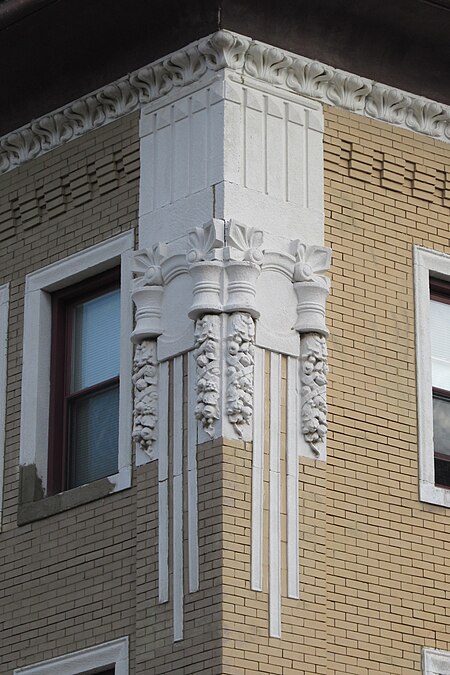
You walk up Walter Street past the usual Hilltop cacophony of vernacular houses with aluminum and vinyl siding, and then suddenly you come upon this explosion of Art Nouveau. The building has lost its balconies (a long time ago, to judge by that tattered aluminum awning) and its cornice, but it retains its utter uniqueness, right down to the balcony doors to nowhere on the second and third floors, which appear to be original and designed specifically for this building rather than ordered from a catalogue.
This strange and wonderful little building is obviously the work of a strange and wonderful architect. But which one? It was built after 1903 but before 1910, and we are sorely tempted to attribute it to Titus de Bobula, whose entire Pittsburgh career blossomed and faded in that period. The treatment of the decorations strongly reminds old Pa Pitt of the Everett Apartments in Shadyside—in fact the decorations are so similar that Father Pitt is nearly convinced they have to be by the same architect. He is not the only one to notice the similarity. A city architecture inventory (PDF) also points it out: “Its similarity to another apartment building in the East End (at Ellsworth Avenue and Copeland Street in Shadyside) further sets the design of 404 Walter apart from the local vernacular found throughout the rest of Allentown.”
To see what both Father Pitt and the city’s architecture experts are talking about, consider these decorations:


Now compare this decoration from the Everett in Shadyside:

The similarity is certainly marked; many of the pieces are identical.(1) Since the Everett is attributed to Titus de Bobula, we are justified in saying that he is a strong possibility for this one, too.
Another De Bobulesque feature is the lack of a main entrance: instead there is a small door off to one side that appears to lead into a stairwell. This is also the case with his Glen Tenement House in Hazelwood and with the Everett. The narrow verticals with asymmetrically staggered windows remind us of St. Michael’s School in Braddock, another De Bobula design (Father Pitt promises to make a pilgrimage to Braddock soon and come back with pictures).
Father Pitt will regard this as a De Bobula building until someone proves otherwise. But he would be delighted to have someone prove otherwise, because then he would be introduced to another eccentric but talented architect.


Footnotes
- Father Pitt will point out, however, that it is just possible that these decorations were standard items from some supplier of terra-cotta building ornaments. (↩)

Leave a Reply